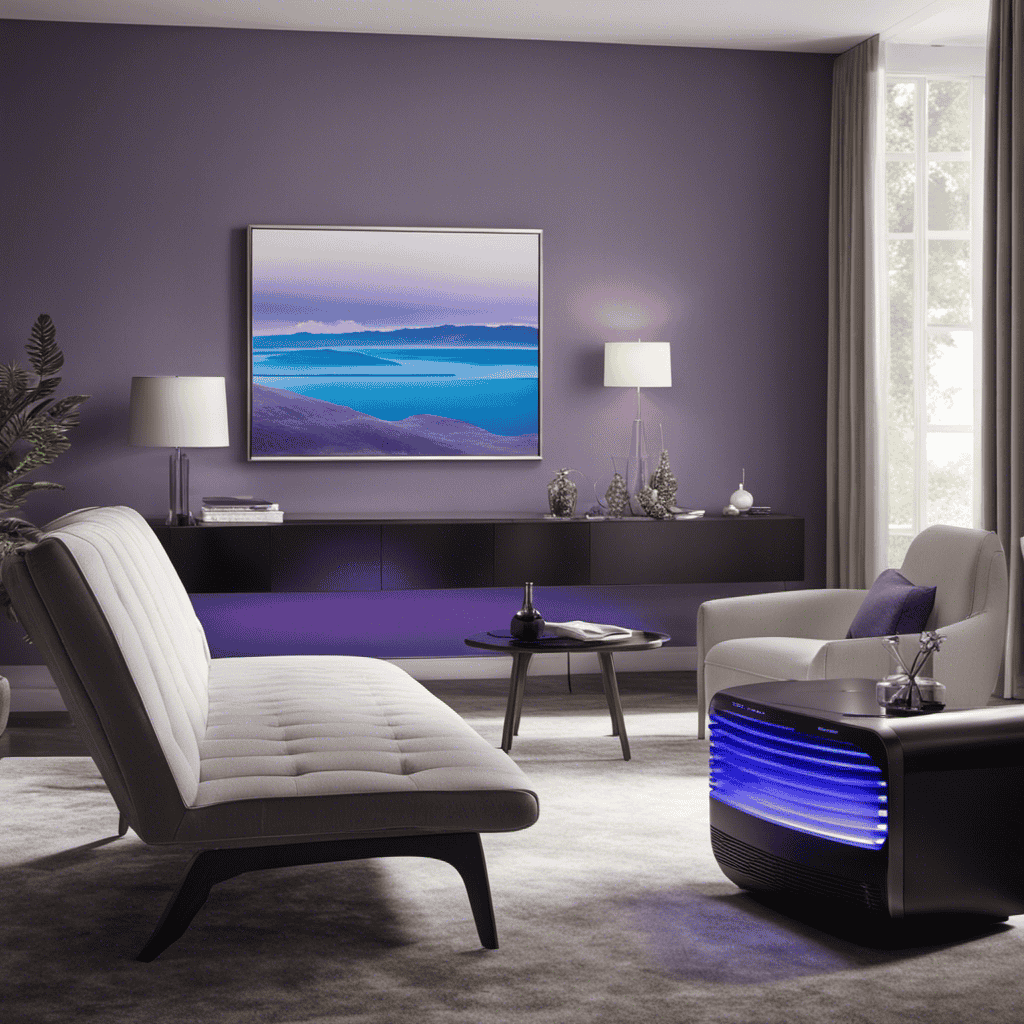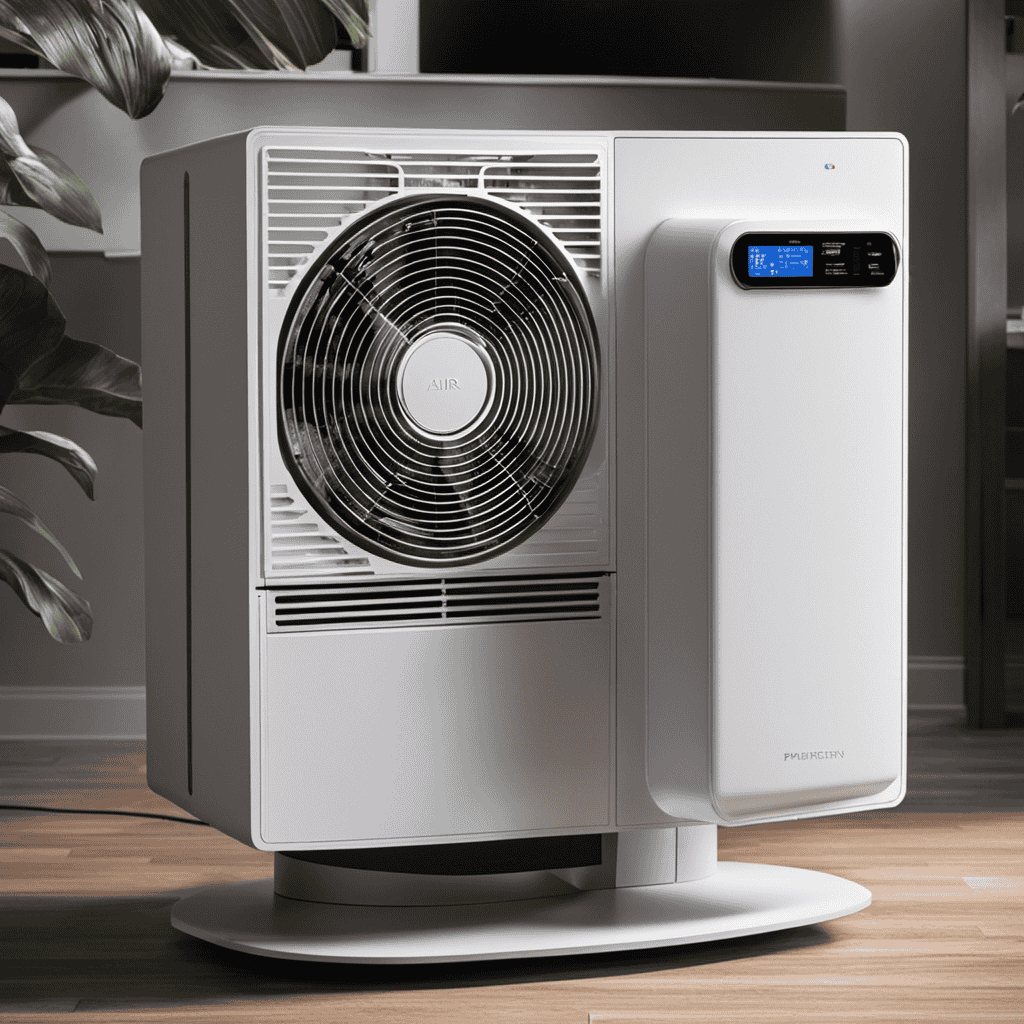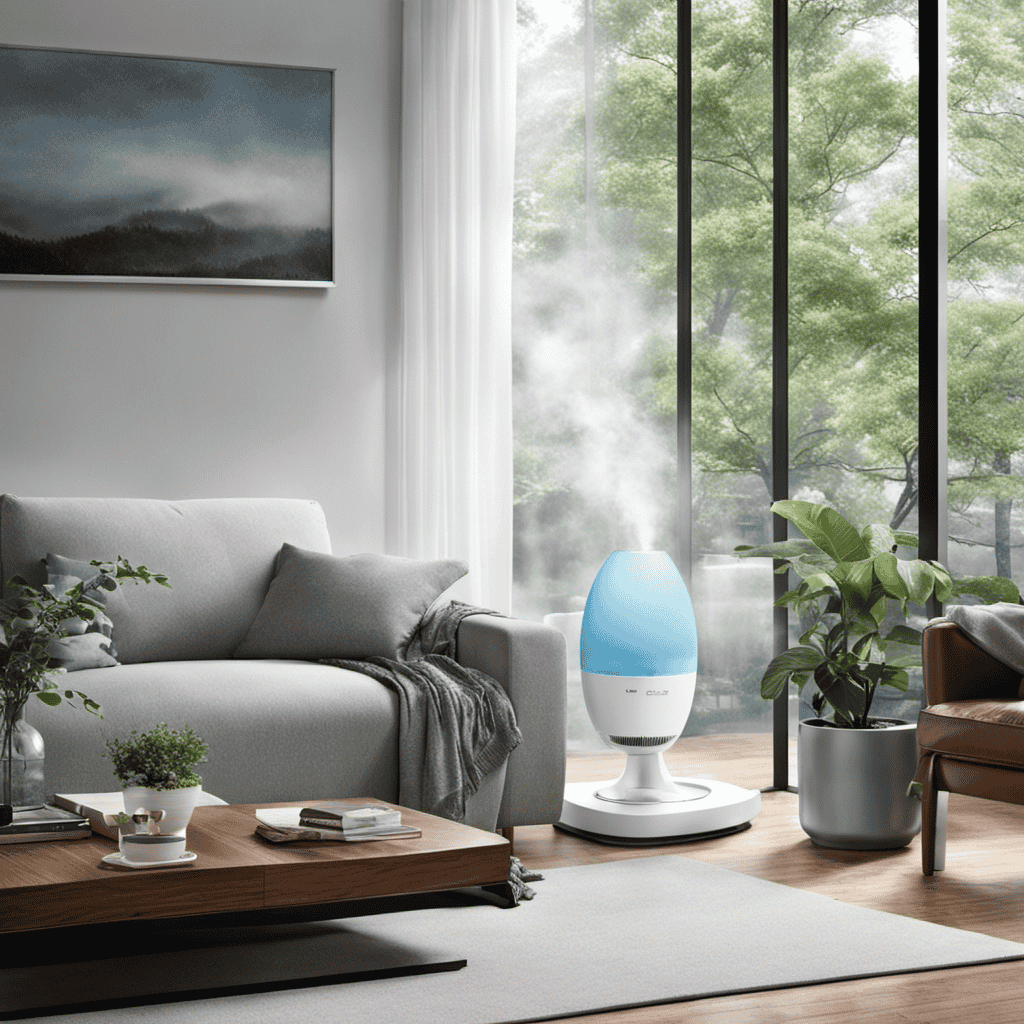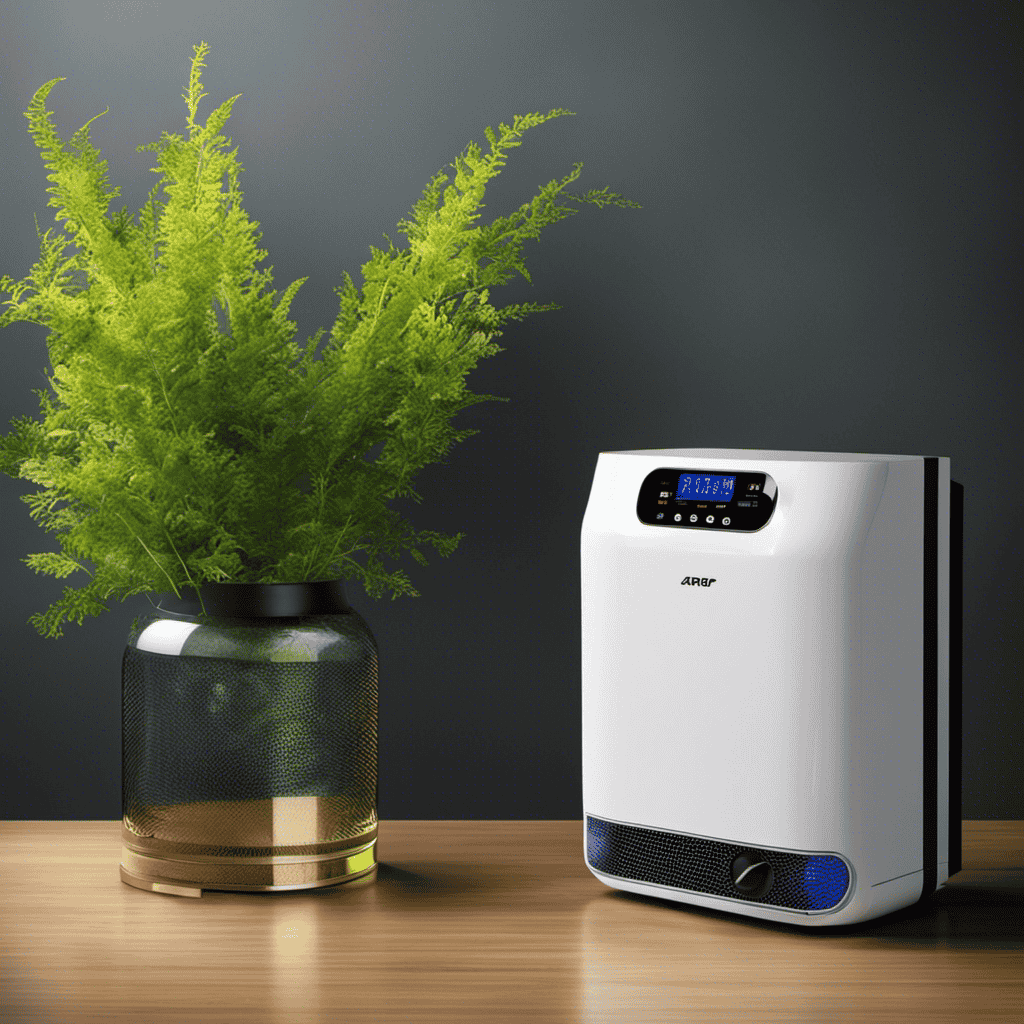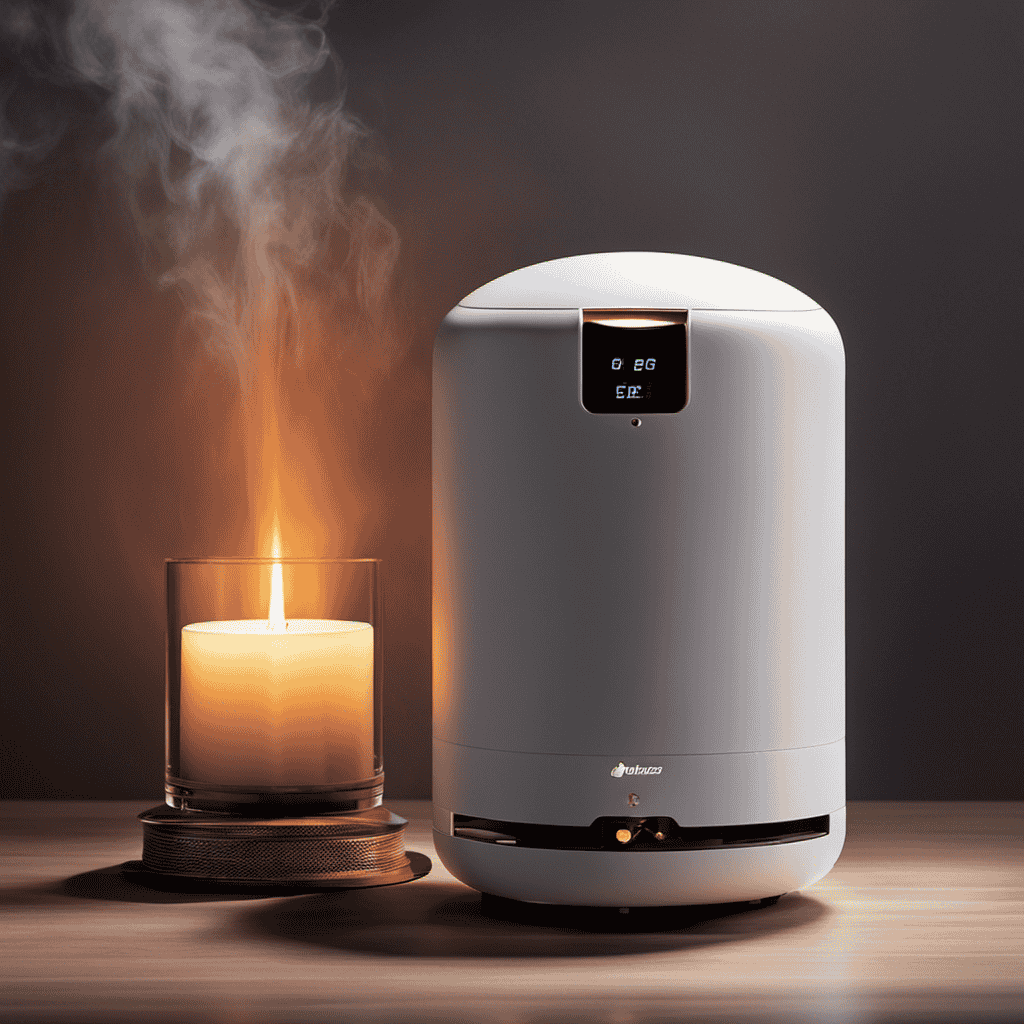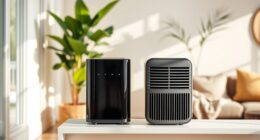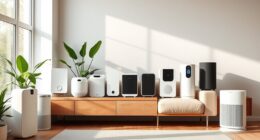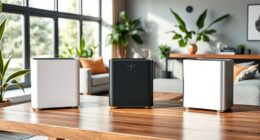I am here to share information about ionizing air purifiers, the innovative devices that are designed to enhance the indoor air quality of your home.
These machines work by releasing negatively charged ions into the air, which attach to harmful particles and neutralize them.
With their advanced technology, ionizing air purifiers effectively eliminate pollutants and allergens, providing you with cleaner and fresher air to breathe.
In this article, I’ll delve into the science behind ionizing air purifiers, explore their benefits, and discuss their safety compared to traditional air purifiers.
Let’s dive in!
Key Takeaways
- Ionizing air purifiers release negative ions into the air, which attach to positively charged particles and make them heavy, causing them to fall out of the air.
- Ionizing air purifiers can reduce respiratory irritants, alleviate allergies and asthma symptoms, and create a cleaner and healthier living environment.
- Ionizers can be more effective at removing smaller particles like smoke and allergens, but may not be as effective at removing larger particles or VOCs. HEPA filters and activated carbon filters are better for these types of pollutants.
- It is important to choose an ionizing air purifier with low ozone emission levels and to use them in well-ventilated areas. Regular maintenance and cleaning are also necessary to minimize potential health risks.
The Science Behind Ionizing Air Purifiers
The science behind ionizing air purifiers involves the release of negative ions to neutralize harmful particles in the air. Ionizing air purifier technology advancements have made significant strides in improving indoor air quality.
These devices work by emitting negative ions into the air, which attach themselves to positively charged particles such as dust, pollen, and bacteria. This process causes the particles to become heavy and fall out of the air, effectively removing them from circulation.
Negative ions also have the ability to neutralize airborne pathogens, making the air healthier to breathe. The role of negative ions in air purification is crucial, as they not only eliminate harmful particles but also contribute to a fresher and more invigorating indoor environment.
With ongoing research and development, ionizing air purifiers continue to evolve, providing even more effective and efficient air purification solutions.
How Ionizing Air Purifiers Work
When it comes to understanding how ionizing air purifiers work, there are three key points to consider: the ion production process, airborne particle attraction, and the health benefits that come with using these devices.
Firstly, the ion production process involves the emission of negative ions into the air, which attach themselves to positively charged particles. This process helps to neutralize and remove harmful particles from the air, improving overall air quality.
Secondly, these negatively charged ions attract airborne particles such as dust, pollen, and smoke, causing them to become heavy and fall to the ground or be easily captured by the purifier’s filters.
Lastly, the health benefits of using ionizing air purifiers include reducing respiratory irritants, alleviating symptoms of allergies and asthma, and creating a cleaner and healthier living environment.
Ion Production Process
An ionizing air purifier uses an electric field to create ions by removing electrons from air molecules. The ion generation mechanism involves applying high voltage to sharp metal needles or plates. This creates a strong electric field, charging the air molecules. As the molecules pass through the field, electrons are stripped away, creating positively charged ions. These ions are released into the air and dispersed throughout the room.
To measure ion concentration, ion counters or ion meters are used. These specialized instruments detect and quantify the number of ions in the air. They provide valuable information about the effectiveness of the ionizing air purifier.
Airborne Particle Attraction
Using a strong electric field, an ionizing air purifier attracts airborne particles to its charged ions. This process helps to effectively remove pollutants and improve indoor air quality.
Here’s how it works:
- The ionizing air purifier generates negative ions, which are charged particles.
- These negative ions are released into the air and create an electric field.
- As airborne particles come into contact with the electric field, they become charged.
- The charged particles are then attracted to the negatively charged ions produced by the air purifier.
Health Benefits Explained
You can experience improved health by using this device, as it effectively filters out pollutants and creates a cleaner indoor environment.
Air purification methods have come a long way in recent years, and one of the most advanced technologies utilized is ionization. Ionization technology works by emitting negatively charged ions into the air, which attach themselves to airborne particles, such as dust, allergens, and bacteria.
These charged particles then become attracted to positively charged surfaces, such as walls or furniture, effectively removing them from the air. This process not only reduces the number of harmful particles in the air but also helps to eliminate odors and neutralize harmful gases.
Benefits of Ionizing Air Purifiers
There are several benefits to using ionizing air purifiers in your home. These devices use ionization technology to remove harmful particles from the air, providing a cleaner and healthier environment. Here are four key benefits of using ionizing air purifiers:
-
Reduction of Allergens: Ionizing air purifiers can effectively remove allergens such as pollen, dust mites, and pet dander from the air. This can greatly benefit individuals with allergies, as it helps to alleviate symptoms and improve overall respiratory health.
-
Asthma Relief: People with asthma often struggle with poor air quality, which can trigger symptoms and exacerbate their condition. Ionizing air purifiers can help to remove asthma triggers such as smoke, mold spores, and volatile organic compounds (VOCs), providing relief and improving air quality.
-
Odor Elimination: Ionizing air purifiers are also effective at eliminating unpleasant odors caused by cooking, pets, or chemical fumes. By neutralizing odor-causing particles, these purifiers can leave your home smelling fresh and clean.
-
Bacteria and Virus Control: Ionizing air purifiers can help to reduce the spread of bacteria and viruses in your home. By emitting negatively charged ions, these purifiers can neutralize and remove harmful pathogens from the air, reducing the risk of illness.
Common Types of Ionizing Air Purifiers
When it comes to ionizing air purifiers, there are several factors to consider.
First, there are both pros and cons to using these devices. While they can effectively remove particles from the air, there is also the potential for ozone production and the need for regular maintenance.
Speaking of effectiveness, it is important to evaluate the performance of these ionizers in terms of their ability to improve air quality.
Lastly, proper maintenance and cleaning are crucial to ensure the optimal functioning of ionizing air purifiers.
Pros and Cons
One of the pros of using an ionizing air purifier is that it effectively removes airborne particles and allergens from the environment. It can also help neutralize odors and smoke. Additionally, ionizing air purifiers can cover a larger area than traditional air purifiers and require low maintenance since there are no filters to replace.
However, there are some cons to consider when using ionizing air purifiers. They produce ozone as a byproduct, which can be harmful in high concentrations. They may also not be as effective in removing larger particles. In terms of cost, ionizing air purifiers can be more expensive compared to traditional air purifiers. Lastly, these air purifiers require regular cleaning of ionizing plates to maintain efficiency.
Overall, it’s important to weigh the pros and cons before deciding if an ionizing air purifier is the right choice for your needs. While they offer benefits such as effective particle removal and odor neutralization, they also have drawbacks like ozone production and higher cost.
Effectiveness of Ionizers
In the previous subtopic, I discussed the pros and cons of ionizing air purifiers. Now, let’s delve into the effectiveness of ionizers and compare them with other types of air purifiers.
Ionizers are known for their ability to remove pollutants from the air by releasing negatively charged ions. These ions attach to positively charged particles, such as dust and allergens, causing them to clump together and fall out of the air.
However, it is important to note that ionizers also produce ozone as a byproduct. While ozone can help eliminate odors and kill bacteria, high levels of ozone can be harmful to our health. This is why it’s crucial to choose an ionizer that meets safety standards and has ozone emission levels within acceptable limits.
When comparing ionizers with other air purifiers, it’s worth mentioning that ionizers are generally more effective at removing smaller particles like smoke and allergens. However, they may not be as effective at removing larger particles or volatile organic compounds (VOCs). Other air purifiers, such as HEPA filters and activated carbon filters, are better suited for these tasks.
Maintenance and Cleaning
Maintaining and cleaning an ionizer is essential to ensure its optimal performance and prolong its lifespan. Here are some maintenance tips and a troubleshooting guide to help you keep your ionizer in top shape:
-
Regularly clean the ionizer’s collection plates or filter. This removes the accumulated dust and particles and allows proper airflow.
-
Check for any loose connections or damaged wires. Ensure that all components are securely attached and functioning properly.
-
Clean the air intake vents to prevent blockages and maintain proper airflow. Use a soft cloth or brush to remove any dust or debris.
-
If you notice a decrease in performance or unusual noises, consult the manufacturer’s troubleshooting guide or contact customer support for assistance.
Are Ionizing Air Purifiers Safe
Are ionizing air purifiers safe to use in homes with children and pets?
When it comes to air purifier safety, it is important to consider the potential health risks. Ionizing air purifiers work by releasing negative ions into the air, which attach to particles and make them fall out of the air. While this can be effective in removing pollutants, there are some potential health risks associated with ionizing air purifiers.
The negative ions produced can react with oxygen molecules in the air, creating ozone. High levels of ozone can be harmful, especially for individuals with respiratory conditions and young children. Therefore, it is crucial to choose an ionizing air purifier that produces low levels of ozone and to use it in a well-ventilated area.
Regular maintenance and cleaning of the purifier are also essential to ensure optimal performance and minimize any potential health risks.
Factors to Consider When Choosing an Ionizing Air Purifier
When it comes to choosing an ionizing air purifier, there are several important features to consider. These features include the unit’s filtration system, coverage area, noise level, and energy efficiency.
Additionally, it’s essential to understand the potential health benefits of ionizers. They can remove harmful particles from the air, alleviate allergies, and improve overall indoor air quality.
Important Features to Consider
To choose the right ionizing air purifier for you, consider these important features:
-
Air Flow Rate: Look for a purifier with a high air flow rate to ensure efficient purification of your space.
-
Filtration System: Check if the purifier has a multi-stage filtration system, including a pre-filter, HEPA filter, and activated carbon filter, to effectively remove dust, allergens, and odors.
-
Coverage Area: Determine the size of the area you need to purify and choose a purifier that can adequately cover that space.
-
Noise Level: Consider the noise level of the purifier, especially if you plan to use it in your bedroom or office, where quiet operation is important.
These factors are essential when selecting an ionizing air purifier. By carefully assessing these features, you can make an informed decision and find a purifier that best suits your needs.
Health Benefits of Ionizers
One of the health benefits of ionizers is that they can help improve indoor air quality. Ionizers work by emitting negative ions into the air, which attach to positively charged particles like dust, pollen, and pet dander. This process causes these particles to become heavy and fall to the ground, effectively removing them from the air we breathe.
Improved indoor air quality can have a positive impact on our overall health, reducing the risk of respiratory issues and allergies. However, it’s important to note that there are potential negative effects associated with long-term use of ionizers. Some studies suggest that prolonged exposure to high levels of negative ions may have detrimental effects on our health, such as respiratory irritation and increased asthma symptoms.
It is recommended to use ionizers in moderation and follow the manufacturer’s guidelines to minimize any potential risks.
Ionizing Air Purifiers Vs. Traditional Air Purifiers
Ionizing air purifiers are more effective at removing airborne particles compared to traditional air purifiers. Here’s why:
-
Ionizing air purifiers work by emitting negative ions into the air, which attach to airborne particles and make them heavier. This causes the particles to fall to the ground or be easily captured by the purifier’s filters.
-
Ozone generators, on the other hand, produce ozone as a byproduct. While ozone can help eliminate odors, it is a lung irritant and can be harmful to humans and pets when present in high concentrations.
-
HEPA filters are commonly used in traditional air purifiers. While they are effective at capturing larger particles, they may not be as efficient in removing smaller particles like allergens, bacteria, and viruses.
-
Ionizing air purifiers, with their ability to remove a wide range of particles, including those as small as 0.1 microns, provide superior air purification compared to ozone generators and traditional air purifiers with HEPA filters.
Maintenance Tips for Ionizing Air Purifiers
Now that we have discussed the differences between ionizing air purifiers and traditional air purifiers, let’s focus on the maintenance techniques and best practices for ionizing air purifiers. Proper maintenance is crucial to ensure the optimal performance and longevity of your ionizing air purifier. Here are some key maintenance tips to keep in mind:
| Maintenance Tips for Ionizing Air Purifiers |
|---|
| Regularly clean the collection plates or grids according to the manufacturer’s instructions. |
| Replace the filters as recommended by the manufacturer to maintain efficient air purification. |
| Keep the surrounding area clean to prevent dust and debris from accumulating on the purifier. |
| Regularly inspect the unit for any signs of damage or malfunction and address them promptly. |
The Impact of Ionizing Air Purifiers on Indoor Air Quality
To truly understand the impact of ionizing air purifiers on your indoor air quality, it’s important to consider their ability to remove harmful particles and improve the overall freshness of your living space. Here are some key factors to consider regarding the effectiveness of ionizing air purifiers and the safety concerns associated with them:
-
Particle removal: Ionizing air purifiers use charged ions to attract and remove airborne particles, such as dust, allergens, and pollutants.
-
Odor elimination: These purifiers can help neutralize unpleasant odors by breaking down volatile organic compounds (VOCs) present in the air.
-
Fresh air circulation: Ionizing air purifiers can improve air circulation, ensuring that clean, filtered air is distributed throughout your space.
-
Safety concerns: Some ionizing air purifiers produce ozone as a byproduct, which can be harmful to human health. It’s important to choose models that comply with safety regulations and have low ozone emissions.
Understanding the Limitations of Ionizing Air Purifiers
If you’re considering using an ionizing air purifier, it’s important to understand the limitations and potential drawbacks associated with this type of device.
While ionizers are effective at removing certain particles from the air, they also have negative effects that need to be considered. One potential risk is the production of ozone, which can be harmful to our health, especially for individuals with respiratory issues. Ionizers can also generate harmful byproducts such as formaldehyde and other volatile organic compounds (VOCs).
Another limitation is that ionizing air purifiers mainly target small particles, such as dust and pollen, but may not effectively remove larger particles or odors. Additionally, ionizers require regular maintenance, including cleaning the plates or filters, to maintain their effectiveness.
It’s crucial to weigh these potential risks and limitations before deciding on using an ionizing air purifier.
Frequently Asked Questions
What Are the Potential Side Effects of Using an Ionizing Air Purifier?
Potential health risks and safety concerns should be considered when using an ionizing air purifier. It’s important to note the possible side effects, such as ozone production, which can irritate the respiratory system.
Can Ionizing Air Purifiers Remove Specific Allergens, Such as Pet Dander or Pollen?
Ionizing air purifiers can help prevent asthma attacks by removing specific allergens like pet dander and pollen. They are generally safe for children, but it’s important to monitor their use and follow safety guidelines.
Do Ionizing Air Purifiers Produce Any Noticeable Noise While Operating?
No, ionizing air purifiers do not emit any noticeable noise while operating. However, it is important to consider the pros and cons of these purifiers, as well as the potential for harmful byproducts in the air.
Are Ionizing Air Purifiers Effective in Eliminating Odors, Such as Cigarette Smoke or Cooking Smells?
Yes, ionizing air purifiers effectively eliminate odors like cigarette smoke and cooking smells. They improve indoor air quality by releasing negative ions that attach to pollutants, neutralizing them. There are no health risks associated with using them.
How Long Do the Ionizing Plates in an Ionizing Air Purifier Typically Last Before Needing to Be Replaced?
To maintain the efficiency of ionizing plates in an ionizing air purifier, it is important to clean them regularly. Follow the manufacturer’s instructions for proper cleaning techniques and frequency of maintenance.
Conclusion
In conclusion, ionizing air purifiers are a remarkable invention that revolutionizes indoor air quality. With their ability to eliminate harmful particles and odors, these purifiers create a fresh and clean environment for everyone to enjoy.
Although they may not be a magical solution to all air quality problems, their benefits are undeniable. So, if you’re looking for a way to transform your living space into a breath of fresh air, an ionizing air purifier is the way to go. Trust me, you won’t be disappointed!
